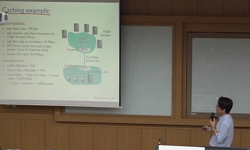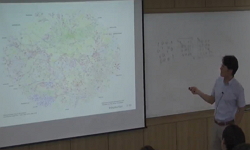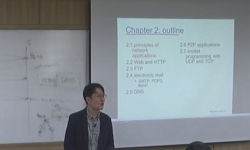21세기는 모든 경제주체들이 서로 연결되어 있는 네트워크의 시대다. 오늘날 세계 경제의 급속한 환경변화에 적응하기 위한 기업 전략은 자본, 노동, 기술, 정부정책 등과 같은 전통적 요소...
http://chineseinput.net/에서 pinyin(병음)방식으로 중국어를 변환할 수 있습니다.
변환된 중국어를 복사하여 사용하시면 됩니다.
- 中文 을 입력하시려면 zhongwen을 입력하시고 space를누르시면됩니다.
- 北京 을 입력하시려면 beijing을 입력하시고 space를 누르시면 됩니다.
한국 조선산업의 발달과 하청협력 네트워크의 공간 특성 : 삼성중공업 거제조선소를 사례로 = (The) Growth and Spatial Features of Subcontracting Networks on the Korean Shipbuilding Industry : The Case of Samsung Heavy Industry in Geoje, Korea
한글로보기https://www.riss.kr/link?id=T9466888
- 저자
-
발행사항
광주 : 전남대학교 대학원, 2004
-
학위논문사항
학위논문(박사)-- 전남대학교 대학원: 지리학과 2004. 2
-
발행연도
2004
-
작성언어
한국어
- 주제어
-
KDC
530.9 판사항(4)
-
DDC
338.09 판사항(20)
-
발행국(도시)
광주
-
형태사항
xii, 235p. : 삽도 ; 30cm.
-
일반주기명
지도교수 : 이정록
참고문헌: p. 214-227 - 소장기관
-
0
상세조회 -
0
다운로드
부가정보
국문 초록 (Abstract)
21세기는 모든 경제주체들이 서로 연결되어 있는 네트워크의 시대다. 오늘날 세계 경제의 급속한 환경변화에 적응하기 위한 기업 전략은 자본, 노동, 기술, 정부정책 등과 같은 전통적 요소뿐만 아니라 지식·정보기술,연구개발, 제도적 조건 등을 포함하는 다양한 요소들이 유기적으로연결되어 있는 네트워크에 대한 관심이 증대되고 있다. 네트워크에 관한 연구는 기업간 관계가 성숙되어 있는 자동차나 전자·통신산업 등이 중심이었고, 조선산업에 관한 지리학적 연구는 대규모 조선소 입지가 지역경제에 미친 영향을 중심으로 이루어져 왔다. 본 연구에서는 우리 나라 조선산업의 일반적 특성과 성장에 관한 이론적 고찰과 세계적 조선기업인 삼성중공업 거제조선소 하청협력 네트워크에 관한 경험적 분석을 통하여 다음과 같은 몇 가지 결론을 도출하였다.
첫째, 조선산업은 기술, 경영, 제도적 조건에 있어 일반 제조업과는 사잉한 특성을 보이고 있다. 조선산업은 전후방관련효과가 큰 종합산업으로 1970년대 이후 매출액, 부가가치, 고용, 수출·입 등의 측면에서 국민경제에 큰 몫을 담당하고 있다. 그리고 철저한 주문자생산 방식을 따르고 있는 조선산업의 생산공정은 개별적이고 단속적인 흐름생산이며 선형이나 선종에 따른 변화가 매우 크다.
둘째, 우리 나라 조선산업은 대규모 기업군의 계열사를 중심으로 비교적 짧은 기간에 남동해안지역에 집중적으로입지하였다. 대규모 조선소의 입지는 자연적, 사회적, 정책적 조건에 있어 일반 제조업과는 상이한 특성을 보이고 있다. 삼성조선이 입지하고 있는 거제지역은 자연환경 조건이 양호하여 작업능률이 높을 뿐만 아니라 사회경제적 조건이 양호하여 각종정보나 기술, 그리고 부품 등의 공급에 있어 유리한 입지작 조건을 갖추고 있다. 정책적 차원에 있어서도 조선산업은 산업화 초기부터 국가전략산업으로 지정되었으며, 특히 거제지역은 일찍부터 조선공업지역으로 지정되어 대규모 조선소 건설의 토대가 될 수 있었다.
셋째, 오늘날 조선산업은 대규모 조선소 내부의 생산체계 변화에 따른 외부화의 필요성과 하청협력업체의 생산기술 향상에 의하여 하청협력 네트워크가 보다 강화되고 있다.삼성조선은 조달체계에 있어 내재화된 부품생산은 거의 없으며, 대부분은 조선전문대리점이나 하청협력업체를 통한 외부거래가 보편적인 거래 관행을 이루고 있다. 삼성조선 하청협력 네트워크의 공간조직체계에 있어 용역서비스 형태로 생산공정에 직접 참여하는 거제지역에서는 대면접촉을 통한 역동적인 거래관계로 발전하고 있다. 국내적으로는 거래관계가 긴밀한 소수의 계열기업이나 협력업체협의화 소속 업체들이 중심이 되어 모기업과의 공식·비공식적인 접촉을 통한 협력관계를 강화해 나가고 있다. 그리고 국제적 범위에서는 조선 선진국의 부품업체나 상사(agent)를 중심으로 주로 고기술·고부가가치 부품들을 장기간 공급받고 있으며, 최근에는 중국이나 동남아시아 지역을 중심으로 노동집약적인 블록제작업체들의 비중이 증가하고 있다.
넷째, 삼성조선 하청협력 네트워크의 공간 특성은 설립초기에는 국내적으로 우리 나라 조선산업의 중심인 부산지역이, 국제적으로 조선 선진국인 유럽과 일본의 업체들이 중심이었지만, 오늘날은 지리적으로 인접한 경남지역(창원, 김해)과 일본, 중국을 비롯한 아시아지역의 중요성이 크게 증가되고 있다. 삼성조선 하청협력 네트워크의 공간적 특성에서 모기업 주변지역에는 집적하는 국지적 네트워크는 모기업 의존도가 절대적이고, 거래관계가 영속적이며, 공정 연계성이 높은 업체들이 대부분이다. 이에 비해 공간적으로 분산도니 비국지적 하청협력 네트워크는 모기업 의존도가 상대적으로 낮고, 표준화된 제품(주로 국내업체)이나 전문기술을 활용하는 부품(주로 해외 업체)을 거래하는 업체로 구분되어 나타났다.
다섯째, 모기업과의 성공적 거래관계 형성에 있어 요인별 특성은모기업과 지리적으로 인접한 지역일수록, 거래규모가 클수록, 거래지속기간이 길수록, 공정 연관성이 강할수록, 납품비중이 높을수록, 거래만족도가 높을수록, 협력업체협의회에 가입한 업체일수록 중요도가 높게 나타났다. 모기업과의 안정적인 거래관계를 유지하기 위해서는 모기업이나 정부의 직접적인 경제적, 기술적 지원보다는 하청협력업체 의 자발적인 노력이 더 중요한 요인으로 작용하고 있다. 그리고 삼성조선 하청협력업체의 성공적인 기업간 협력관계를 위한 변수들간 상관관계의 지역별 특성에서 모기업과의 거래관계가 성숙되어 있는 거제지역 사내업체, 타산업과의 거래관계가 보편화되어 있는 경남·울산지역, 자체적인 경쟁력을 어느 정도 확보하고 있는 부산지역 하청협력업체들은 변수들간 유의한 상관관계가 낮게 나타났다.이에 비해 모기업과의 거래관계가 성숙되어 있지 않고, 거래구모도 탄력적인 거제지역 사외 하청협력업체, 수도권지역, 국내 기타지역 하청협력업체들은 변수들간 높은 상관관계를 통하여 모기업과의 거래관계를 유지하려 하고 있다.
결론적으로 오늘날 하나의 기업집단으로 시스템화된 경쟁구조 하에서 하청협력업체에 대한 모기업의 핵심전략은 선택과 집중전략을 통하여 전문화된 중핵적 중간기업을 공간적으로집적시켜 육성하는 것이다. 이에 조응하는 하청협력업체의 전략은 무조건적인 외부 지원을 기대하기보다는 주어진 조건 하에서 자체적인 경쟁력을 강화하여 모기업과의 적극적인 협력관계를 지향해 나가는 것이다. 이 과정에서 하청협력 네트워크의 공간 특성은 국내적으로 모기업 주변에서 입지하는 사내·외 하청협력업체들은 공정연계를 중심으로 모기업 생산네트워크에 포함되어 있고, 그 외 국내지역에 입지하는 업체들은 다양한 부품을 중심으로 거래관계가 형성되어 있어 지역적으로 뚜렷한 차이를 보이고 있다. 그리고 국제적 범위에 있어서도 우리 나라의 자체적인 기술력 성장으로 유럽이나 일본 중심에서 중국이나 동남아시아지역으로 중심축이 이동하고 있다. 이러한 네트워크 체계의공간 특성은 조선산업 하청관계의 지역분화의 증거가 될 수 있으며, 모기업의 공간전략과 하청협력업체의 이전이나 신규입지에 있어 중요한 자료로 이용될 수 있을 것으로 생각된다.이런 점에서 본 연구는 삼성조선 하청관계의 공간 특성과 협력관계를 모기업과 하청기업의 입장에서 경험적으로 확인함으로서 우리나라 조선산업 하청협력 네트워크 특성에 관한 지라학적 지평을 확대할 수 있을 것으로 사료된다.
다국어 초록 (Multilingual Abstract)
The 21st century is a century of networks. To adapt themselves to rapid curcumstances in a global economy, companies are becoming interested in systematic networks, which include not only conventional factors such as capital, labor, technology, and go...
The 21st century is a century of networks. To adapt themselves to rapid curcumstances in a global economy, companies are becoming interested in systematic networks, which include not only conventional factors such as capital, labor, technology, and governmental policy, but also knowledge and information technology, research, institutional conditionals, and so on. The study of networks has centered around the automobile, eletronics and communication industries. The geographical studies of the shipbuilding industry have been made, centering around effects on community economies caused by the location of large scale shipbuilding yards. This study effects on community economies caused by the location of large scale shipbuilding yards. This study makes a theoretical invstigation of the growth and general charanteristics of the Korean shipvuilding industry and makes an empirical analysis of subcontracting networks of Samsung Heavy Industry's Geoje Shipyard. The results are as follows:
First, the shipbuilding industry shows different characteristics from other manufacturing industries in technology, mnagement, and institutional conditions. It is a composite industry, having forward-backward linkage effects, which have implications for the national economy since the 1970s, looking at is from the aspect of amounts, added value, employment, and export and import trade. It also adheres to former order-after production methods. The manufacturing processes in the shipbuilding industry are separated and disconnected and are highly liable to variation by models or kinds of ships.
Second, the shipbuilding industry in Korea deveoped rapidly on the southeastern coastal sites forming interrelated enterprises with big company groups. The locationof a big shipbuilding company shows a different characteristic from other manufacturing industries in nutural, social and political conditions. The Geoje area, where Samsung Shipyard is located, not only has good natural conditions which facilitiate supplies of information, technology, and parts. As notional policy, the shipbuilding industry has been designated as a national strategic industry since the beginning of industrialization in Korea. Since the Geoje area was designate as a region for the shipbuilding industry, is was possible to construct a big shipbuilding company in teh Geoje area.
Third, these days subcontracting networks are strengthened in the shipbuilding industry owing to the need of externalization caused by the change in production system and the technology development ability of subcontracting firms. In the supply system of Samsung Shipyard, internal parts prooduction is rarely used, and most parts are supplied through subcontracting firms or special agencies for shipbuilding. In the spatial organization system of Samsung Shipyard subcontracting networks, active dealing relations assuming the form of services through facing contacts are formed by participating directly in the production process. Within the country, the cooperative relation is becoming strengthened through the formal and informal contacts with minor interrelated company and subcontracting council members. In world-wide relations, high tech and high added value parts have been supplied on a long term basis by trading companies or parts firms from advanced shipbuilding nations, but recently intensive labor firms are increasing in China or southeastern Asina countries.
Fourth, at an early stage, a spatial arena for subcontracting networks in Samsung Shipyard was the Busan, a center for the Korean shipbuilding industry, and also for companies in Europe or Japan. But nowadays the importance of other areas of Asia, including Japan, China, and Gyeonam Changwon and Gimhae is greatly increasing. In the spatial characteristics of Samsung subcontracting networks, the local networks formed around a interrelated company deeply depend on the mother company. Subcontracting relations with the mother company are long lasting, and most subcontracting firms also had relations with the mother company are long lasting, and most subconstracting firms also had relations with the mother company in the manufacturing process. On the other hand, in the non-local networks decentralized spatially the degree of dependence on the mother company was relatively low, and the domestic firms mainly deal with standardized products, but foreign firms trade the most of special technology.
Fifth, the characteristic for successful dealings with the mother company are as lollow: the closer to the mother company the firms are; the bigger the dealing sizes are; the longer the dealings last; the stronger the manufacturing process relations are; the higher the rate of delivered goods is; the better the feeling of satisfaction is; the stronger the subcontracting council firms is, the higher the importance of the dealing relationship is. To keep a stable dealing relationship with the mother company, the subcontracting firms' spontaneous efforts are more important than the direct economic and technological support of the mother company or the government. In the relational varialbles for successful cooperation between subcontracting firms of Samsung shipbuilding company, the sigmificance of the correlation between firms within the company in the Goeje area and subcontracting firms in Gyeongnam, Ulsan, and Busan areas was low. In contrast with this, the significance of the crrelation between firms outside the company in the Goeje area, the subsontracting firms of the Seoul metropolitan, and other areas was high.
In conclution, under the systematized structure of a single business group, the mother company's core strategy for subcontracting firms is to foster specialized intervening firms through selection and concentration strategy. To meet this strategy, subcontracting firms need to seek active cooperative relations with the mother company by strengthening their competitive power under the given conditions rather than expecting unconditional external support. In the spatial characteristics of the subcontracting networks, there is a clear difference in dealing relationships between the subcontracting firms in the Goeje area and teh other regions. And in the international scale, the central axis is moving from Europe or Japan towards China or other southeatern Asina areas owing to the growth of independent technological power in Korea. These spatial characteristic in the network system are evidence of regioal specialization in subcontracting relations of the shipbuilding industry. The results not only could be used in determining a new location or moving subcontracting firms, but also could help plan a spatial strategy for the mother company. Therefore,it is considered that this study will enlarge the boundaries of geographical knowledge of the subcontracting cooperative networks in Korea's shipbuilding industry by identifying Samsung Shipyard's spatial charanteristics in subcontracting relations and cooperative relations from the mother company and the subcontracting firm's point of view.
목차 (Table of Contents)
- 목차 = ⅰ
- 제1장 서론 = 1
- 제1절 연구배경과 연구목적 = 1
- 제2절 연구방법 및 연구지역 개관 = 4
- 1. 연구방법 및 연구내용 = 4
- 목차 = ⅰ
- 제1장 서론 = 1
- 제1절 연구배경과 연구목적 = 1
- 제2절 연구방법 및 연구지역 개관 = 4
- 1. 연구방법 및 연구내용 = 4
- 2. 연구지역 개관 = 8
- 제2장 연구동향 및 이론적 논의 = 13
- 제1절 연구동향 = 13
- 1. 네트워크 연구의 의의 = 13
- 2. 네트워크의 개념과 네트워크에 관한 선행연구 = 15
- 3. 조선산업에 관한 선행연구 = 25
- 제2절 하청협력 네트워크에 관한 이론적 논의 = 30
- 1. 기업간 거래관계 유형과 네트워크의 공간 특성 = 30
- 2. 기업간 하청협력 네트워크 특성 = 39
- 제3절 소결 = 56
- 제3장 조선산업의 발달과 지역적 전개 = 59
- 제1절 조선산업의 특성 = 59
- 1. 선박과 조선산업의 정의 = 59
- 2. 조선산업의 일반적 특성 = 61
- 3. 조선산업의 생산공정 특성 = 64
- 4. 조선산업의 국민경제상 특성 = 65
- 제2절 우리 나라 조선산업의 발달과정 = 68
- 1. 세계 조선산업의 역사 = 68
- 2. 우리 나라 조선산업의 발달과정 = 70
- 3. 우리 나라 조선산업의 성장 추이 = 79
- 4. 우리 나라 조선관련산업의 지역적 분포 = 80
- 제3절 삼성조선의 입지와 성장과정 = 89
- 1. 입지조건 = 89
- 2. 성장과 기업현황 = 94
- 3. 노동구조 특성 = 102
- 제4절 삼성조선의 생산네트워크 특성 = 106
- 1. 기술협력 네트워크 = 106
- 2. 하청거래 네트워크 특성 = 111
- 3. 사내하청 네트워크 특성 = 121
- 4. 생산네트워크의 제도적 조건 = 125
- 5. 조선산업 생산네트워크의 발전과정 = 130
- 제5절 소결 = 136
- 제4장 삼성조선 하청협력 네트워크 : 모기업을 중심으로 = 138
- 제1절 삼성조선 하청협력 네트워크의 특성 변화 = 138
- 1. 1995년 하청협력 네트워크 특성 = 138
- 2. 2001년 하청협력 네트워크 특성 = 140
- 3. 1995년과 2001년 하청협력 네트워크 특성 비교 = 143
- 제2절 삼성조선 하청협력 네트워크의 세계화-국지화 특성 = 145
- 1. 국제적 범위의 하청협력 네트워크의 공간 특성 = 145
- 2. 국가적 범위의 하청협력 네트워크의 공간 특성 = 151
- 3. 국지적 하청협력 네트워크 특성 = 155
- 4. 거리에 따른 하청협력업체의 공간분포 = 159
- 제3절 소결 = 161
- 제5장 삼성조선 하청협력 네트워크 : 하청협력업체를 중심으로 = 163
- 제1절 삼성조선 하청협력 네트워크의 기업간 관계 = 163
- 1. 하청협력업체의 일반적 특성 = 163
- 2. 하청협력업체의 하청구조 특성 = 168
- 3. 기술협력 네트워크 특성 = 172
- 4. 모기업과의 거래관계 특성 = 176
- 제2절 조선산업의 성공적 거래관계 = 186
- 1. 조선산업의 성공적 거래관계의 요인별 특성 = 186
- 2. 조선산업의 성공적 거래관계의 변수간 관련성 = 196
- 제3절 소결 = 205
- 제6장 요약 및 결론 = 207
- 제1절 연구결과의 요약 = 207
- 제2절 연구의 의의와 한계 = 211
- 참고문헌 = 214
- (Abstract) = 228
- 부록(설문지) = 232












